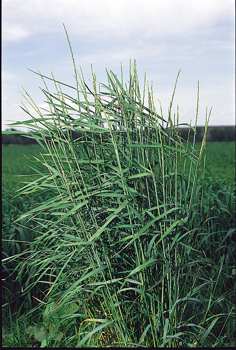Crops
Roegneria trachycaulon Nevski. - Slender wheatgrass, slender wildrye.
Taxonomic position.
Family Poaceae Barnhart., genus Festuca L.Synonyms.
Agropyron brevifolium Scribn., Agropyron pauciflorum (Schwein.) Hitchc. ex Silveus, Agropyron tenerum Vasey, Agropyron teslinense Porsild & Senn, Agropyron trachycaulum (Link) Malte ex H. F. Lewis, Roegneria pauciflora (Schwein.) Hyl., Triticum trachycaulum Link, Agropyron caninum (L.)Biology and morphology.
Chromosome number: 2n=28. Slender wheatgrass has a cespitose growth habit. The root system is dense, consisting of coarse and fine fibrous roots which extend more than 30 cm deep. The culm is usually erect, 60-120 cm tall, slender, green, and glabrous. Leaves range from 8 to 33 cm long and 0.6 to 1.3 cm wide, and the basal leaves are longer than the upper leaves. Sheaths are round and open, sometimes purplish at the base. A narrow white band characterizes the leaf edges. The inflorescence is a spike, generally 10-25 cm long, erect, slender, with one spikelet per node. The spikelets are well-spaced, each overlapping one half of the next, though the lowest spikelet often does not overlap the one above it. Lemmas and glumes have a short awn. Lemmas are coarsely hairy. The auricles are 0.3-1 mm long or absent. The ligule is a rounded, ciliate membrane, 0.4-0.8 mm long. The weight of 1000 seeds is 2.8 to 3.1 g. Blossoms in June, seeds ripen in July. Cross-pollinated by wind.Distribution.
Introduced into Russia in 1913 from North America. Cultivated beginning in the 1930s on small plots in the forest-steppe and mountain areas in 33 regions and republics of the former USSR. The state permits the utilization of 9 breeding cultivars for forage and pasture purposes.Ecology.
Meso-xerophyte, adapted to temperate regions. Very drought-, cold- and frost-resistant. Resistant to early-fall and late-spring frosts. Slender wheatgrass grows in dry to moist, medium-textured soil. It is adapted to a wide range of soil types but prefers sandy loams; it tolerates silt and clay but does best on sandy loam. This species has a high salt tolerance. Soil pH usually ranges from moderately acidic to moderately alkaline, although it has been found growing in soils with a pH as high as 8.8. It grows better than smooth bromegrass or crested wheatgrass in heavy-textured soils and has been used in mixtures on irrigated land. Slender wheatgrass is surpassed only by tall wheatgrass in its ability to tolerate alkaline soils. It is less drought-resistant than crested or western wheatgrass.Utilization and economic value.
Slender wheatgrass is relatively short-lived. It yields well for the first 3 to 4 years, and then the stand density decreases rapidly. Because of this characteristic, it is suggested that it be used in mixtures with other grasses which are more persistent but slow to establish. Good yields of quality hay are obtained from slender wheatgrass stands when cut before it becomes harsh and woody. When used for hay, it should be sown in mixtures with more permanent species (alfalfa, awnless brome, meadow-fescue and crested wheatgrass), which will take over the stand as the slender wheatgrass dies out. It increases in forage yield during the first two to three years after seeding. Its protein content is lower than that of crested wheatgrass and smooth bromegrass during the early part of the season and at maturity, but it is about equal at mid-season. Slender wheatgrass begins its growth relatively early in the spring and produces an abundance of palatable forage liked by all kinds of livestock. It is not resistant to close grazing, and heavy grazing reduces stands quickly. Species improves soil structure and fertilization. Used for erosion control. Forage yield is approximately 14.0-27.0 MT/ha; dry matter yield is 3.0-6.0 MT/ha; average seed yield is 400-400 kg/ha.Reference citations:
Catalog of state permitted cultivars of agricultural crops. 1969. -M.: Kolos, 489 pp. (In Russian)Catalog of state permitted cultivars of agricultural crops. 1971. -M.: Kolos, 488 pp. (In Russian)
Catalog of state permitted cultivars of agricultural crops. 1974. -M.: Kolos, 480 pp. (In Russian)
Catalog of state permitted cultivars of agricultural crops. 1985. -M.: Kolos, V. 3, 489 pp. (In Russian)
Golovkin B.N. 1988. Cultigenic plant area. Moscow: Nauka. 184 pp. (In Russian)
Kashtanov A.N., ed. 1983. The Natural-agricultural regions and utilization of soil resources of the USSR. -M.: Kolos, 336 pp. (In Russian)
Medvedev P.F., Smetannikova A.I. 1981. The forage crops of European part of the USSR. Leningrad: Kolos. 336 pp. (In Russian)
Shashko D.N. 1967. Agroclimatic region of the USSR. Moscow: Kolos. 335 pp. (In Russian)
Shashko D.N. 1985. Agroclimatic resources of the USSR. Moscow: Kolos. 248 pp. (In Russian)
Soil resources of the USSR (Agricultural regions of areas and republics of USSR). 1990. -M.: -V. 1, 260 pp. (In Russian)
State register of breeding achievements permitted for utilization. Plant cultivars. 1994. -M.: -218 pp. (In Russian)
State register of breeding achievements permitted for utilization. Plant cultivars. 1996. -M.: -171 pp. (In Russian)
State register of breeding achievements permitted for utilization. Plant cultivars. 1999. -M.: -192 pp. (In Russian)
State register of breeding achievements permitted for utilization. Plant cultivars. 2000. -M.: -232 pp. (In Russian)
State register of breeding achievements permitted for utilization. Plant cultivars. 2001. -M.: -252 pp. (In Russian)
State register of breeding achievements permitted for utilization. Plant cultivars. 2003. -M.: -236 pp. (In Russian)


